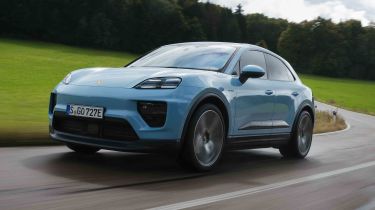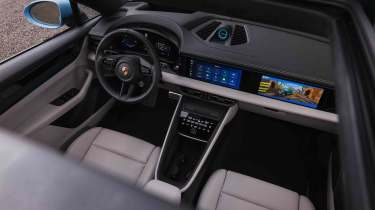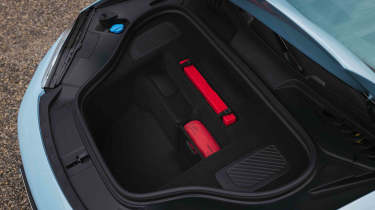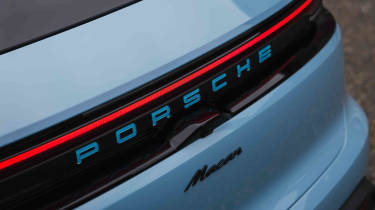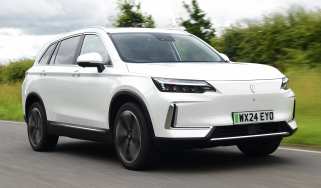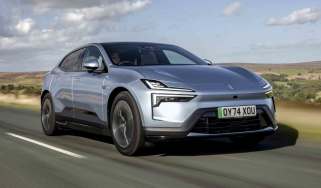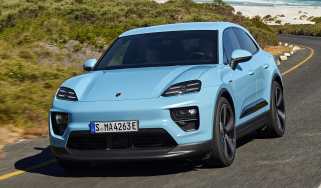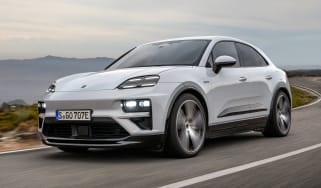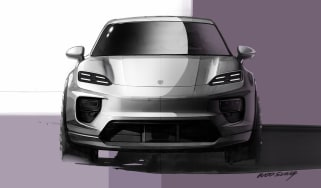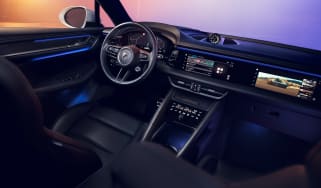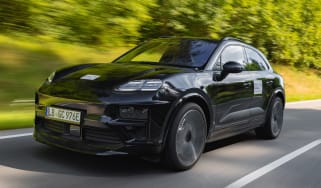Porsche Macan Electric review
Hi-tech, good to drive, and with a high-end interior, the Macan Electric feels like a proper Porsche

Is the Porsche Macan Electric a good car?
The Porsche Macan Electric feels like a Porsche in all the right ways: cutting-edge technology, a carefully crafted cabin and sharp yet approachable driving dynamics. It all adds up to make this one of the best all-round electric cars on the market.
Yes, the Turbo is faster, but the more sensible Macan 4 Electric is our pick of the four-wheel-drive versions. The cheaper rear-wheel-drive model has the best range of all and loses little to the four-wheel-drive versions dynamically, plus has the best ride of the range. But with all versions, be careful with the options list; you can make this a six-figure SUV without too much effort.
| Key specs | |
| Fuel type | Electric |
| Body style | SUV |
| Powertrain | 96kWh battery (useable), 1x e-motor 96kWh battery (useable), 2x e-motors |
| Safety | 5-star (Euro NCAP, 2024) |
| Warranty | 3yrs, unlimited miles |
How much does the Porsche Macan cost?
There’s a special set of ingredients that makes a Porsche, a Porsche. It’s an ever-evolving recipe, but the basic principles remain; a Stuttgart-spawned sports car or SUV must be the best-driving vehicle of its type.
That’s a trait that also extends to the electric era. The Porsche Taycan is widely regarded as one of the sharpest saloon cars on sale – distilling much of what makes the Porsche 911 so successful, into a zero-emission executive express. You can even have one with a big boot, or jacked-up, pseudo-SUV styling.
So after easing itself in, Porsche now turns its attention to the popular Porsche Macan. This BMW X3 rival is EV only, with a choice of single and dual-motor powertrains – both mated to a hefty 100kWh (96kWh usable) battery for up to 399 miles of range in single-motor, rear-wheel-drive form.
More reviews
The less expensive versions of the Macan Electric range will take the lion’s share of sales, starting with a rear-wheel-drive model with conventional coil-sprung suspension, but a Turbo model (without an actual turbo, of course) is also available for those looking for serious performance.
Prices start from £68,500 for the single-motor, rear-wheel drive but, as with any Porsche, the options list is extensive, so it’s quite easy to get a Macan 4 Electric (which starts at a little over £71,000) to cost more than £95k with a few options. That’s roughly the same price as a Macan Turbo Electric, which costs almost £97,000 before options. In between these two extremes is the 4S, costing nearly £77,000.
There are two standard paint colours: black and white, though up to 59 ‘special’ shades are available at extra cost. As standard, the Porsche Macan Electric has 20-inch wheels, with 21 and 22-inch rims on the options list – the most expensive of which will set you back more than £6,000.
The interior is black as standard, though ‘Chalk’ accents are a relatively affordable £176. Leather starts from around £1,200, while ‘Extended’ leather is more than double that, but brings softer materials throughout, including the lower parts of the doors and dash.
Elsewhere, every car comes with eight-way electrically-adjustable heated seats, two-zone climate control, twin screens with Apple CarPlay and Android Auto, plus LED lights and those aforementioned 20-inch wheels.
As mentioned earlier, the entry-level Macan Electric has a single motor and rear wheel drive, while the 4, 4S, and Turbo have a dual-motor, four-wheel-drive layout. A GTS model is on the cards, but the Stuttgart manufacturer isn’t planning a Turbo S version at this stage.
Engines, performance & drive
What’s particularly pleasing about the Porsche Macan Electric is the control weights. No, the steering doesn’t have the granularity of an old hydraulic rack, but it’s precise and consistent, and the grip on offer means the car will turn on a dime. The biggest barrier to the Macan’s agility is its weight, though even that is pretty well-contained thanks to a centre of gravity that is 140mm lower than the old car’s.
The accuracy of those controls extends to the pedals, too. Acceleration is strong but progressive, making it easy to modulate and feed in power out of the bends. The brakes are just as smooth; there are no adjustable brake energy regen settings, but the transition between recuperation and the conventional discs and pads is absolutely seamless.
If the Macan Electric struggles in any one area, it’s ride comfort – specifically at lower speeds and around town. There are precious few ways to circumnavigate an electric SUV’s essential raised ride height and hefty kerbweight, other than to fit slightly stiffer suspension. This firm setup is something that can cause the Macan Electric to fidget over rough surfaces and clunk through deeper potholes.
Both the cars we tried were on adaptive air suspension (a £2,064 option on the 4), but the smaller 20-inch wheels offered a noticeable improvement – especially in an urban environment. Both versions (4 and Turbo) felt more pliant and tied down on the motorway or over faster, more undulating roads.
In terms of straight-line speed, we suspect only a handful of owners will feel the need to step up from the base Macan or Macan 4 Electric to the flagship Turbo. Even the entry-level car has 335bhp (355bhp on overboost, with Launch Control) and can do 0-62mph in 5.7 seconds. The Macan 4 Electric provides 382bhp; it doesn’t feel as urgent or snappy as a Tesla Model Y Performance, but the softened throttle serves up a more comfortable experience in day-to-day driving. If this isn’t enough, the 630bhp Macan Turbo Electric will do 0-62mph in just 3.3 seconds.
| Model | Power | 0-62mph | Top speed |
| Macan Electric | 335bhp | 5.7 seconds | 137mph |
| Macan 4 Electric | 402bhp | 5.2 seconds | 137mph |
| Macan Turbo Electric | 630bhp | 3.3 seconds | 162mph |
Range, emissions & running costs
Porsche claims up to 398 miles on a charge using the WLTP test procedure for the single-motor version. Driving a dual-motor Macan 4 Electric on a fast and demanding test route showed an overall efficiency of around 2.9m/kWh, which translates to a real-world range of around 275 miles. However, we reckon a gentler right foot would easily see that figure surpass the magic 300-mile mark.
But the good news is that if you do drain that battery quicker than you might like, the Porsche’s 800-volt architecture allows for ultra rapid charging peak of 270kW, which should mean that a 10-80 per cent top-up can be completed in just 21 minutes.
The Macan Electric gets two 11kW AC charge ports (one on either side) to make home or on-street charging more convenient. The big battery means a full charge via a conventional 7kW home wallbox is likely to take the best part of 13 hours.
All Macan Electric models get a separate eight-year or 100,000-mile warranty for the battery pack, guaranteeing it will maintain above 70 per cent capacity for that period, otherwise it’ll be replaced.
Insurance costs for the Macan Electric are likely to be on par with rivals like the Audi Q6 e-tron, starting in group 45 for the entry-level Macan Electric, before rising to group 50 for the quickest Turbo version. If you need a quick electric SUV that’s more affordable to insure, you’ll have to look at a Volvo EX40, because its quickest Twin Motor Performance version is in group 40.
According to our depreciation data, the Porsche Macan Electric is likely to hold on to its value better than its closest rivals. After three years or 36,000 miles, the Macan Electric is likely to hold on to between 55 to 57 per cent of its original value. That’s better than the Audi Q6 e-tron (50 to 55 per cent) and the Mercedes EQE SUV (49 to 53 per cent).
| Model | Battery size | Range | Insurance group |
| Macan Electric | 96kWh (useable) | 399 miles | 45E |
| Macan 4 Electric | 96kWh (useable) | 381 miles | 46E |
| Macan Turbo Electric | 96kWh (useable) | 367 miles | 50E |
Design, interior & technology
The idea of making a Porsche feel like a Porsche extends to more than just the driving experience. You must feel unequivocally cocooned in the cabin, surrounded by intuitive, tactile buttons and switches, and responsive, crystal-clear screens.
Thankfully, the Macan Electric ticks almost all of these boxes. There is plenty of adjustment in the seat and steering wheel, and the displays are typically easy to read. Some of the climate functions are touch-operated, but things like the temperature and fan speed use physical switches. The cooled wireless charging pad is among the fastest and most effective we’ve used.
Quality, on the whole, is very good and befitting the car’s near-£70k base price. There are some cheaper plastics if you go searching in the lower reaches of the cabin, but you’ll rarely notice any evidence of cost-cutting.
Beware, however, because – like on all Porsches since the dawn of time - the options list is long. Even our Macan 4 Electric test car came with more than £25,000 of options, so it’s difficult for us to truly assess what a base-spec car might look like. We suspect the Extended Leather package (£2,805) could cover a multitude of sins. The question is, how often do you touch the door bins or the lower dash? This may or may not matter to you, but be careful if you’re working to a budget.
Sat-nav, stereo and infotainment
The Android Automotive-based infotainment is quick to respond and you can even option a passenger-side display if you wish. We wouldn’t bother – it seems a frivolity, and a cost that could be better spent elsewhere. After all, it’s hardly a stretch for your nearest and dearest to use the central screen instead.
Speaking of which, that main infotainment system is typical Porsche. The fonts are familiar, and the functionality is on point. Most of the menus are fairly logically laid out, and the processor behind it all seems pretty slick.
Personally, we’d avoid the augmented-reality head-up display (an extra £1,694). Porsche claims it can, in effect, project up to 10 metres in front of the car – equivalent to an 87-inch screen directly in front of your eyes – but at times, it’s a little distracting.
Boot space, comfort & practicality
Despite adding 86mm to the wheelbase, Porsche hasn’t transformed the first electric Macan into a Range Rover rival. Space in the back is just about sufficient for taller adults, though specifying a panoramic roof eats into headroom. The hard-backed Sports Seats (standard on the Turbo) limit legroom, too. Parents with children who need child seats will find two ISOFIX mounting points on the outer positions of the rear bench.
Depending on the angle you view it from, this latest Porsche Macan can look more like a jacked-up hatchback than a full-blown SUV. The sloping roof helps with aerodynamics – Porsche claims the lower drag coefficient versus the old Macan is equivalent to 85km (53 miles) of range – and while it doesn’t impede proceedings in the cabin, it’ll limit how much you can put in the boot versus, say, a BMW iX3.
Still, the 540-litre boot space (480 litres for the Turbo) is a good size, and the seats fold 40:20:40 to boost versatility when you need to carry longer items. There’s an 84-litre space under the bonnet for the charging cables, too.
Towing preparation comes as standard, though you’ll pay extra for the tow bar itself. Have one fitted, and the Macan is rated to tow up to 2,000kg.
You may also want to have a rear wiper fitted for around £300. Not having such a thing might be fine in California where rain is infrequent, but it’s a bit mean to charge for something like that in a country like ours with such variable weather conditions.
| Dimensions | |
| Length | 4,784mm |
| Width | 1,938mm |
| Height | 1,622mm |
| Number of seats | 5 |
| Boot space | 540-1,348 litres (480-1,288 litres Turbo), plus 84-litre front boot |
Reliability & safety
Safety experts Euro NCAP have awarded the latest Porsche Macan Electric the maximum five-star score. Despite being based on the same underpinnings, the Audi Q6 e-tron performed slightly better than the Macan Electric in the adult, child, and safety assistance categories.
All cars come with things like automatic emergency braking, plus traffic sign recognition and lane-keep assist. Thankfully we didn’t find these systems too intrusive, even when driving quickly on winding roads or on longer motorway stretches; it’s always a positive if you don’t find yourself reaching for the off switch five minutes into the drive.
With the Macan Electric being so new, it’s impossible to accurately assess any potential reliability woes. That said, Porsche customers are a satisfied bunch – the brand regularly posts top-three finishes in our annual Driver Power owner satisfaction survey.
| Key standard safety features | Euro NCAP ratings |
|
|
Porsche Macan alternatives
The Porsche Macan Electric shares its Premium Platform Electric (plus much of the rest of what you’ll find under skin) with the Audi Q6 e-tron. Other rivals include cars like the BMW iX3, Mercedes EQE SUV, and Genesis Electrified GV70.
Frequently Asked Questions
Every version of the Porsche Macan Electric follows a two-year or 24,000-mile service schedule.
